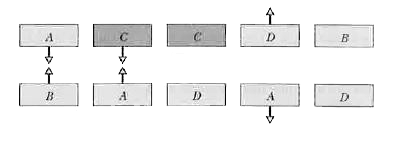The figure shows five pairs of plates : A, B and D are charged plastic plates and C is an electrically neutral copper plate. The electrostatic forces between the pairs of plates are shown for three of the pairs. For the remaining two pairs, do the plates repel or attract each other ?

C and D attract, B and D attract
Topper's Solved these Questions
- ELECTRIC CHARGES AND FIELDSBOOK - RESNICK AND HALLIDAYCHAPTER - ELECTRIC CHARGES AND FIELDSEXERCISE - Problems
63 Videos
- ELECTRIC CHARGES AND FIELDSBOOK - RESNICK AND HALLIDAYCHAPTER - ELECTRIC CHARGES AND FIELDSEXERCISE - Practice Questions (Single Correct Choice Type)
45 Videos
- ELECTRIC CHARGES AND FIELDSBOOK - RESNICK AND HALLIDAYCHAPTER - ELECTRIC CHARGES AND FIELDSEXERCISE - Practice Questions (Integer Type )
3 Videos
- ELASTICITYBOOK - RESNICK AND HALLIDAYCHAPTER - ELASTICITYEXERCISE - PRACTICE QUESTIONS (Integer Type)
3 Videos
- ELECTRIC POTENTIALBOOK - RESNICK AND HALLIDAYCHAPTER - ELECTRIC POTENTIALEXERCISE - (PRACTICE QUESTIONS) Integer Type
1 Videos
Similar Questions
Knowledge Check
The electrostatic force between the metal plate of an isolated parallel plate capacitro C having charge Q and area A, is
AProportional to the square root of the distance the plates.BLinearly proportional to the distance between theCIndepdent of the distance between the platesDInversely proportional to the distance between the platesThe electrostatic force between the metal plate of an isolated parallel plate capacitro C having charge Q and area A, is
Ainveresly proportional to the distance between the plates.Bindependent of the distance between the plates.Cproportional to the square root of the distance between the plates.Dlinearly proportional to the distance between the platesIf Q is the charge on the pates of a capacitor of capacitances C,V the potential difference between the plates, s the area of each plate and d the distance between the plates, the force of attraction between the plates is-
A12(Q2ε0A)B12(CV2d)C12(CV2Aε0)D14(Q2πε0d2)
A metallic slab is introduced between the two charged parallel plates as shown below. Sketch the electric lines of force between the plates.

View SolutionFigure shows two metallic plates A and B placed parallel to each other at a seperation d. A uniform electric field E exists between the plates in the direction from plate B to plate A. Find the potential difference between the plates.

View SolutionFive plates are arranged as shown in the figure and connected across a battery of emf V. The separation between each plate is d and surface area of each plate is A.

View SolutionThe plates of a parallel plate capacitor are charged by a battery and the battery is disconnected after the charging. Now, the plates are placed as shown in the figure. Then (plates are not parallel to each other).
 .
.
View SolutionFive plates are arranged as shown in the figure and connected across a battery of emf V. The separation between each plate is d and surface area of each plate is A.

View Solution
